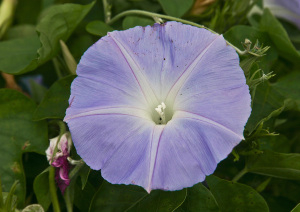Before I moved here I never gave the Morning Glory a second thought: to me it was just a colorful but mostly innocuous ground cover on the beaches of California where I grew up. However, on a small island like Maui they are kind hard to ignore because there are so many of them and they are seemingly everywhere you look. From the high-tide line on most of our white-sand beaches to almost 4,000 feet up Haleakala’s volcanic slopes, their cookie-cutter-perfect flowers and massive amounts of foliage and choking vines spill out over the landscape, engulfing everything from derelict automobiles to the headstones in cemeteries.
The Morning Glories are plentiful in the Hawaiian Islands for two reasons: (1) they are able to adapt to almost any environment and (2) they propagate like oversexed rabbits. Their roots can absorb large quantities of seawater, they tolerate almost any kind of soil, and though they may be torn to shreds and small pieces they are still capable of taking root and flourishing. They choke off the saplings of competing species and shade-out established trees and bushes. On the other hand, Morning Glories can be important pioneer species that stabilize sand dunes and prevent beach erosion.
The Blue Morning Glory (Ipomoea indica)
Ipomoea indica is a perennial vine native (indigenous) to Hawaii (“koali awa” in Hawaiian). It is variously known as Ocean Blue Morning Glory, Blue Morning Glory, and Blue Dawn Flower. It’s also called a “Dunny Creeper” in Australia (a “dunny” is an outhouse toilet), referring to its habit of covering everything in sight with its vines, including small out-buildings. Its geographic origin is uncertain: it may be native to the West Indies. It is now naturalized throughout the tropics and is found on all the main Hawaiian Islands. It is usually found at lower elevations (below 200 m) but has been known to grow at altitudes above 1,200 m.

Close-up of a mature Ipomoea indica plant. Note the characteristic 3-lobed leaves.
(Click on the image to see a larger version.)
Ipomoea indica prefers sunny open ground in a moist environment, but will tolerate seasonal dry spells once it is well established. It is a perennial that grows as a sprawling (ground-hugging) vine that produces a dense ground cover, but it is often seen climbing and twining over other plants. The vine itself (called a “stem”) is softly hairy and may grow to more than seven meters in length. The distinctively shaped leaves are large (as much as 15 cm wide and 17 cm long) and numerous. They may be heart-shaped when immature; mature leaves are 3-lobed to 5-lobed with pointed tips. The upper and lower surfaces of the leaf are covered by silky, short, closely-spaced hairs.
The flower is large (as much as 80 mm in diameter) It usually ranges in color from sky blue to purple-blue; less commonly it may also be light magenta and reddish-pink. It has paler mid-petal bands and a pink to whitish tube inside. The petals (3 to 15 per flower) are joined, which accounts for the distinctive trumpet-like shape of the flower. Ipomoea indica sets flowers all year, continuously flowering during warmer months. The short-lived flowers are replaced as they fall from the vine.
The fruit is a small (about 10 mm in diameter) 3-chambered spherical capsule. These are rarely produced by the plant. It has almost no self-fertilization and so grows vegetatively: its preferred method of propagation is by the production of numerous stolons, stems that grow above ground and are able to produce both roots and foliage. Individual stolons are readily detached from the parent plant and dispersed by mechanical means such as flooding, stream flow, landslides, or human activity (ground clearing and weed removal). Even when badly damaged, a plant can easily recover 4-6 m of its length in a single growth season. One theory about why Ipomoea indica evolved this unique reproductive behavior is that the species is a sterile hybrid and its genes are self-incompatible.
This species contains toxic alkaloids (including Ergonovine, which bears a strong molecular resemblance to Lysergic Acid Diethylamide, or LSD) that discourage ingestion by grazing animals. This defense mechanism contributes to its prevalence as a weed species.

Photo shows the tendency of the Blue Morning Glory to choke off sunlight from other plants by spreading its tendrils and vines in all directions, wrapping itself around anything from tree trunks to derelict automobiles.
(Click on image to see larger version.)
The Blue Morning Glory is a vigorous climbing vine that not only forms a dense ground cover but can easily extend itself high into the forest canopy. The twining stems can quickly choke off the growth of seedlings of other species and smother even older well-established plants. It also poses a significant shading hazard to other species.




